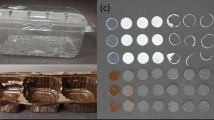Abstract
A simplified approach was devised to recycle sweet whey in production of spore-δ-endotoxin complex from certain entomopathogenic varieties ofBacillus thuringiensis Berliner. The process suggested aimed at the protection of the environment through dual channels namely biological oxygen demand (BOD) reduction of the byproduct under investigation and its incorporation in a microbial fermentation for production of pollution-free biological insecticides. The sweet whey could be used successfully for endotoxin production as complete fermentation media both as such and with simple treatments. Supplementation of whey media with ground leguminous seeds and fodder yeast resulted in marked increase in the yields of endotoxin produced but the toxicity was not increased proportionnally. Standard biological assays revealed high efficiency of certain strains ofB.t. var.entomocidus, kurstaki andgalleriae in producing endotoxins highly active against 3rd instar larvae ofSpodoptera littoralis Boisduval,Spodoptera exigua Hübner andHeliothis armigera Hübner. The suggested approach and the findings obtained are discussed in view of their application feasibilities.
Résumé
Une méthode simplifiée a été mise au point pour recycler le petit lait dans la production du complexe spore-δ-endotoxine de certaines variétés entomopathogènes deBacillus thuringiensis Berliner. Le procédé proposé a pour but la protection de l'environnement par un double canal chimique, c'est-à-dire la réduction de la demande biologique en oxygène du sous produit étudié et son incorporation dans une fermentation microbienne pour la fabrication d'insecticides biologiques non polluants. Le petit lait peut être employé avec succès pour la production d'endotoxine à la fois en tant que milieux complets de fermentation et avec des traitements simples. L'addition aux milieux à base de petit lait de graines de légumineuses et de levure alimentaire aboutit à une augmentation sensible des rendements en endotoxine mais la toxicité n'est pas accrue en proportion. Des essais biologiques normalisés montrent une activité élevée de certaines souches deB.t. var.entomocidus, kurstaki etgalleriae qui produisent des endotoxines très actives à l'égard des larves de 3e stage deSpodoptera littoralis Boisduval,Spodoptera exigua Hübner etHeliothis armigera Hübner. La méthode proposée et les résultats obtenus sont discutés en vue de leur faisabilité d'application.
Similar content being viewed by others
References
Calabrese, D.M., Nickerson, K.W. &Lane, L.C. — 1980. A comparison of protein crystal subunit sizes inBacillus thuringiensis. —Can. J. Microbiol., 26, 1006–1010.
Dulmage, H.T. — 1970. Insecticidal activity of HD-1, a new isolate ofBacillus thuringiensis var.alesti. —J. Invertebr. Pathol., 15, 232–239.
Dulmage, H.T. — 1971. Production of δ-endotoxin by 18 isolates ofBacillus thuringiensis, serotype 3. —J. Invertebr. Pathol., 18, 353–358.
Dulmage H.T., Correa, J.A. &Martinez, A.J. — 1970. Coprecipitation with lactose as a means of recovering the spore-crystal complexe ofBacillus thuringiensis. —J. Invertebr. Pathol., 15, 15–20.
Dulmage, M.T., Boening, O., Rohenborg, C. &Hansen, G. — 1971. A proposed standardized bioassay for formulation ofBacillus thuringiensis based on the international unit. —J. Invertebr. Pathol., 18, 240–245.
Foda, M.S. — 1976. A novel approach for whey utilization in production of native and microbial proteins. —Melchwissenschaft, 31, 138–141.
Foda, M.S., Ismail, A.A. &Khorshid, M.A. — 1977. Biochemical properties of a bacterial Rennin produced from whey. —Milchwissenschaft, 32, 21–23.
Forage, A.J. &Righelato, R.C. — 1979. Progress in Industrial Microbiology. —Elsevier Scientific Publishing Co., Amsterdam, Oxford, New York.
Mann, E.J. — 1977. Whey utilization in food, general infant food and bakery products. —Dairy Industries, 42, 46.
McDonough, F.E. — 1977 Whey solids utilization and salvage systems. —Cultured Dairy Product, J., 8.
Salama, H.S. — 1970. Rearing the corn borerOstrinia nubilalis Hübn, on a semiartificial diet. —Z. Angew. Entomol., 65, 216–218.
Salama, H.S., Foda, M.S. &El-Sharaby, A. — 1981. Potency of spore-δ-endotoxin complexes ofBacillus thuringiensis against some cotton pests. —Z. Angew. Entomol., 91, 388–398.
Scherrer, P.S. &Sommerville, H.J. — 1977. Membrane fractions from the outer layers of spores ofBacillus thuringiensis with toxicity to lepidopterous larvae. —Eur. J. Biochem., 72, 479–490.
Zollikofer, E. — 1974. History of whey utilization. —Schweiz. Landwirtsch. Forsch. 13, 413–420.
Author information
Authors and Affiliations
Rights and permissions
About this article
Cite this article
Salama, H.S., Foda, M.S., El-Sharaby, A. et al. A novel approach for whey recycling in production of bacterial insecticides. Entomophaga 28, 151–160 (1983). https://doi.org/10.1007/BF02372139
Issue Date:
DOI: https://doi.org/10.1007/BF02372139




